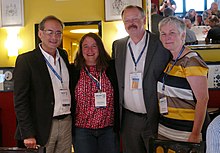Diane Scherzler
Diane Scherzler (* 1970 in Reutlingen ) is a German journalist and studied prehistoric .
Life and work
Diane Scherzler is a great-granddaughter of the Stuttgart xylograph and art collector Emil Scherzler (1850–1921).
From 1990 to 1996 she studied prehistory, geology and prehistoric anthropology at the University of Tübingen , a. a. with Manfred Eggert and Alfred Czarnetzki . Her master's thesis on supporting pessaries from the Iron Age was published in 1998. In 1997 she began her career at SWR , where after freelance work and training as an editor, she initially worked as a project manager in the new media area, then in the central SWR online editorial team as an editor and as a trainer in journalistic training. In 2012 she initiated " Research as a guest in the SWR ", a one-day event in the SWR Studio Tübingen . There, in cooperation with the University Hospital Tübingen, the challenges for high-quality science journalism were examined from the perspective of researchers and SWR employees. She has been working in the Culture Program Directorate since 2013, primarily as a project manager. Lecturer at the Universities of Tübingen and Freiburg and as a freelance media trainer (including University of Tromsø , Helmholtz Center for Environmental Research - UFZ , European Association of Archaeologists , European Molecular Biology Organization , Euroscience , University of Munich , Robert Bosch Foundation , Römisch-Germanisches Zentralmuseum ) she in the field of science and crisis communication.
Volunteering
Diane Scherzler has been a board member of the German Society for Prehistory and Protohistory (DGUF), founded in 1969, since 2011, and since 2014 - as the first woman in the history of this society - its chairman. In this function, together with Frank Siegmund, she initiated a petition against the cancellation of all state funds for the preservation of monuments in North Rhine-Westphalia, which ended up being the largest petition for monument protection in Germany with 27,000 signatures. She is co-initiator of the DGUF annual meetings since 2014, z. B. on topics such as social change and its effects on archeology, the need for a professional association for archeology or shifts in power within and outside archeology and how to deal with them intelligently. As the editor-in-chief of the DGUF's website, newsletter and social media, she set up the DGUF newsletter, which is one of the most widely read archeology newsletters in German-speaking countries with more than 1,650 subscribers, and is responsible for it. She played a key role in the transfer of the DGUF publications to Open Access and is co-editor of the Archaeological Information and Archaeological Sources . Diane Scherzler has been a member of the extended board of the German Archeology Association (DVA) since October 2014. Since 2017 she has been the "Strategy and Communication Consultant" for the German regional group of the Chartered Institute for Archaeologists . At the European Association of Archaeologists (EAA), Diane Scherzler is a member of the “Committee on Communications and Media Strategy”.
Before that, she was a founding member and managing director of COURAGE Culture Care e. V. - a non-profit organization with the aim of examining how the past is dealt with in today's societies. In 2006 she founded and headed the “Science Communication” working group at the European science organization Euroscience .
Publications (selection)
- Material culture and cultural identity: An extracurricular educational project by COURAGE Culture Care eV In: Archaeological information. Volume 20, No. 1, 1997, pp. 137-139. Digitized
- The clay ring from the Viesenhäuser Hof - an indication of medical care in the pre-Roman Iron Age? In: Find reports from Baden-Württemberg. Volume 22/1, 1998, pp. 237-294.
- The clay ring from the Viesenhäuser Hof - A reference to medical care for women in the pre-Roman Iron Age? In: Bärbel Auffermann, Gerd-Christian Less (Ed.): Women - Times - Traces. Exhibition catalog Neanderthal Museum Düsseldorf-Mettmann.
- On humility, power shift and cultural change: Archeology on Web 2.0 sites. In: Nina Schücker (Ed.): Integrating Archeology. Science - Wish - Reality. International Conference on the Social Role, Possibilities and Perspectives of Classical Studies. Roman-Germanic Commission of the German Archaeological Institute. 2012, pp. 237-240.
- A look in the mirror and the perspective of others. On the portrait of archeology in the mass media. In: Anna Simandiraki-Grimshaw, Eleni Stefanou (Ed.): From Archeology to Archeologies - The “other” Past. British Archaeological Reports International Series, 2409. Archaeopress, Oxford 2012.
- Archeology and Monument Preservation in North Rhine-Westphalia 2014 - one year after the struggle against funding cuts and for a better legal basis. In: Archaeological Information. Volume 37, 2014, pp. 153-180. Digitized
Web links
- Diane Scherzler's website
- ORCID Diane Scherzler
- Writings by Diane Scherzler at ResearchGate
- Diane Scherzler on LinkedIn
Individual evidence
- ↑ Wissenschaftskommunikation.de (July 10, 2020). In profile: Diane Scherzler. https://www.wissenschaftskommunikation.de/im-profil-diane-scherzler-40343/
- ^ DGUF eV: Dossier on the funding cuts in archeology and monument preservation in North Rhine-Westphalia and on the DGUF petition. December 31, 2013, accessed on July 21, 2019 (German).
- ↑ CIfA Germany: Board member CIfA Germany, advisory staff. June 24, 2019, accessed on July 21, 2019 (German).
- ↑ D. Scherzler, B. Ulmer: Material culture and cultural identity: An extracurricular educational project by COURAGE Culture Care eV In: Archaeological information . tape 20 , no. 1 . DGUF, S. 137-139 ( uni-heidelberg.de ).
| personal data | |
|---|---|
| SURNAME | Scherzler, Diane |
| BRIEF DESCRIPTION | German journalist and prehistorian |
| DATE OF BIRTH | 1970 |
| PLACE OF BIRTH | Reutlingen |
